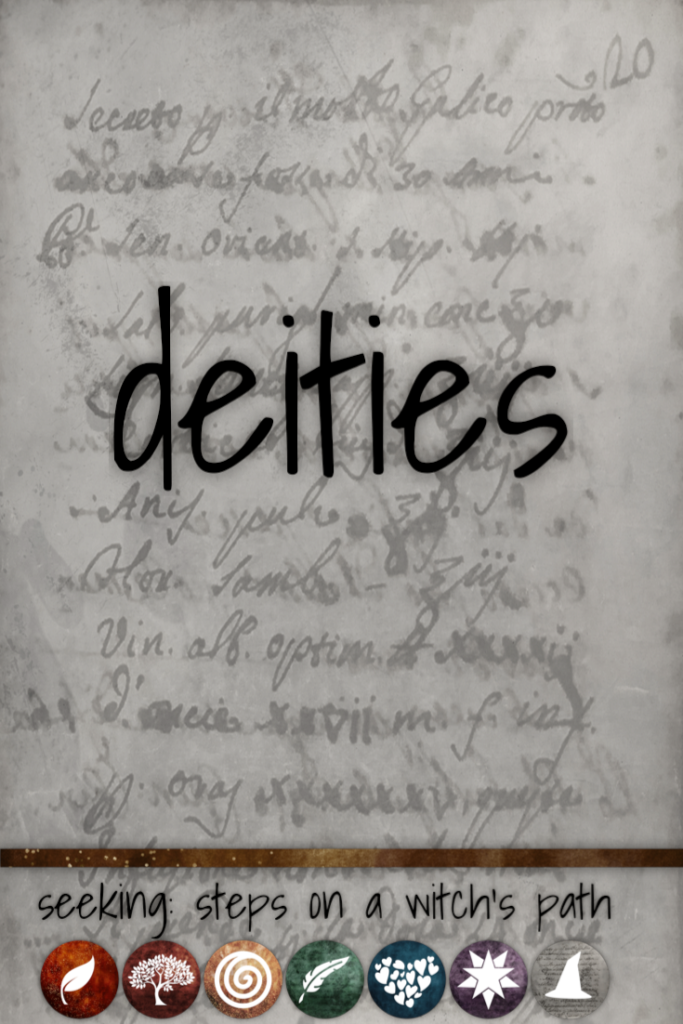One thing you’ll find as you learn more about Paganism is that there are many different views on the nature of deity. That’s true even for people working in the same group or path: two people standing beside each other in ritual might have quite different ideas! This page talks about some of the different common approaches.

Commonly used terms
- Monotheism is the belief or doctrine that there is only one god. ‘Mono‘ means one.
- Duotheistic practices come down to two deities (often male and female, but that’s not the only option.) ‘Duo‘ means two.
- Polytheism is the belief in or worship of many gods (or at least more than one god). ‘Poly‘ means many.
- Pantheism is the idea that deity is present (immanent) in all things. ‘Pan‘ means all.
- Henotheism is the belief in or worship of one god, without denying the existence of others.
There are other useful terms that you’ll see come up fairly regularly.
- Pantheon refers to families of deities (i.e. the Greek pantheon includes Zeus, Hera, Demeter, Hermes, Apollo, Artemis, etc.)
- Archetype is a term used to refer to a idealised individual that generally represents a category, for example Maiden, or Mother, or Crone or King or Warrior or Healer.
- Atheism is either the belief that no gods exist, or denial that gods exist. ‘A’ in Greek is a way to indicate a negative or absence. (So ‘no gods’)
- Agnostic is the term for not being sure about the nature or existence of deity. (‘No knowledge’ – ‘gnosis‘ means knowledge)
How do Pagans look at deity?
Many Pagan religions are either polytheistic or polytheistic in practice (i.e. they behave as if there are multiple distinct gods.)
However, you will also find Pagans who are henotheistic (they focus on one deity, while acknowledging the existence of others), and those who believe that all named deities are part of a single greater divine whole: who see a single face of a given deity, but it all connects in the middle (this is sometimes referred to as the ‘facet’ theory, or more irreverently as the ‘disco ball’ theory.)
There are also a number of people who enjoy Pagan community events, or who practice magic of various kinds who are atheists or agnostics: their practices do not rely on or involve deities.
Reconstructionist paths generally honor the pantheon of that culture (though they may particular attention to one or a few deities from that pantheon more than the entire pantheon). It’s also quite common for an individual to honor a particular deity in their own life, as well as others in group work or at specific festivals.
Religious witchcraft traditions tend to be polytheistic in practice. British Traditional Wicca traditions work with two very specific deities whose names are considered private (oathbound), but who are referred to as the Lord and Lady in public.
Other religious witchcraft traditions may honour only a few specific deities, may work with a variety of deities, or some other combination. Many people in these two groups also develop relationships with a particular deity – a patron deity – they honour in their personal practice.
More eclectic paths may work solely or primarily with archetypes, rather than deities. Some paths trace their deity interactions from duotheism (for example, a God and Goddess: note that this leaves out deities who do not fit into a dualistic model of gender.) There are lots of variations.
My own practice is heavily polytheistic: I believe there are many deities out there, I interact with them as individuals beings (and get to know them as individuals).
Mostly, I work with a small number of deities: deities I honor and work with personally, those the coven works with, and those the tradition works with. I’ll also sometimes attend rituals that honor and work with deities that I don’t have a personal connection with.
(You’ll notice I say ‘honour and work with‘ here. For many Pagans, ‘worship’ can be an imprecise term, or lead to assumptions that might not be accurate. Many Pagans look at their deities as those who are wiser, with vastly more experience, and who are due respect and honour. But they also recognise that those deities benefit from our attention and time and assistance.
So, other terms – honour, work with, respect – are common, and ‘worship’ may be less frequently used, unless it’s truly a situation of worship (leaving specific offerings or prayers or other actions solely to honour and worship the deity.)
Other things out there
Many Pagans also feel there are other beings out there who aren’t present on the physical plane, but who can (and do) interact with us. Some of these include:
- Ancestors: By blood and family connection, but also by choosing a similar life path – for example, those who were witches, teachers, priest/esses in life.
- Elemental powers: Beings associated with a particular element that forms life (in Wiccan and much of western witchcraft practice, these are air, fire, water, and earth.)
- Guardians of various kinds.
- Locus genii or spirits of place. Common in a wide variety of folk traditions, these are spirits who are intimately connected with a particular physical connection or place.
- Other beings. Commonly the Fae, Good Folk, etc. by whatever name a culture uses, or other beings who are neither of this physical world nor deities.
Some paths and traditions are very specific about their interactions with some or all of these. Others aren’t.
Why are there so many variations?
That’s in large part because Pagan religions tend to form around shared practices (orthopraxy) rather than shared beliefs (orthodoxy).
Obviously, every religion has a bit of both. But this means that people don’t need to share the same beliefs about deity to do ritual together or to share ritual or practice ideas.

Last edited December 23, 2016



